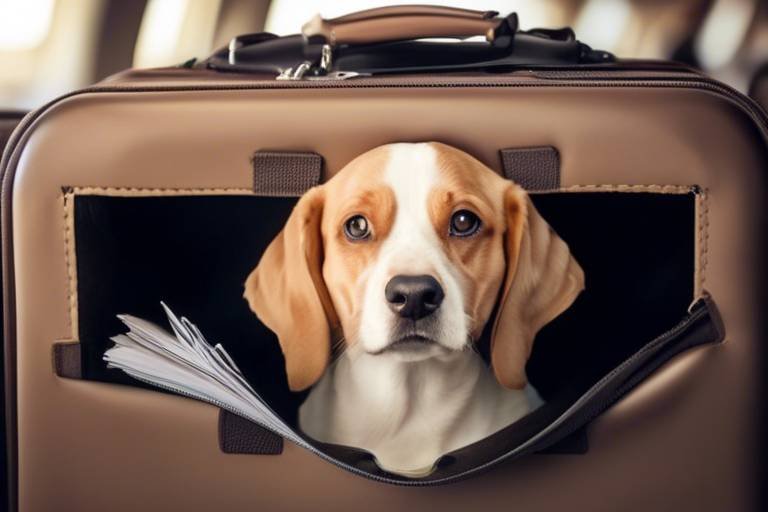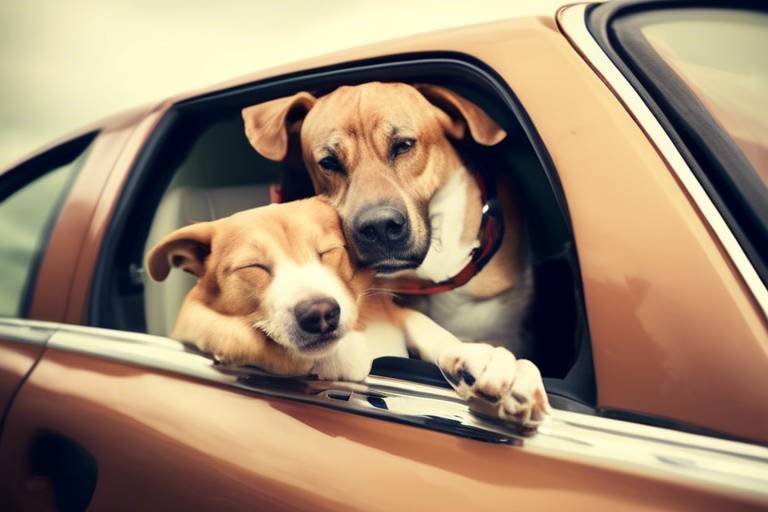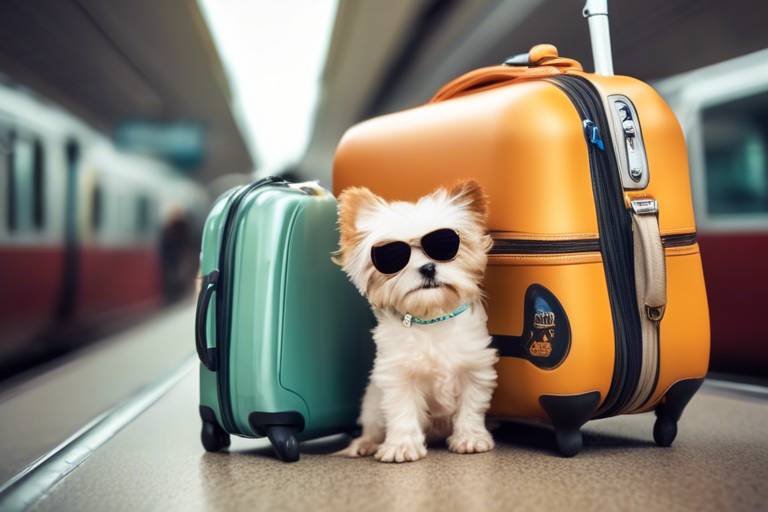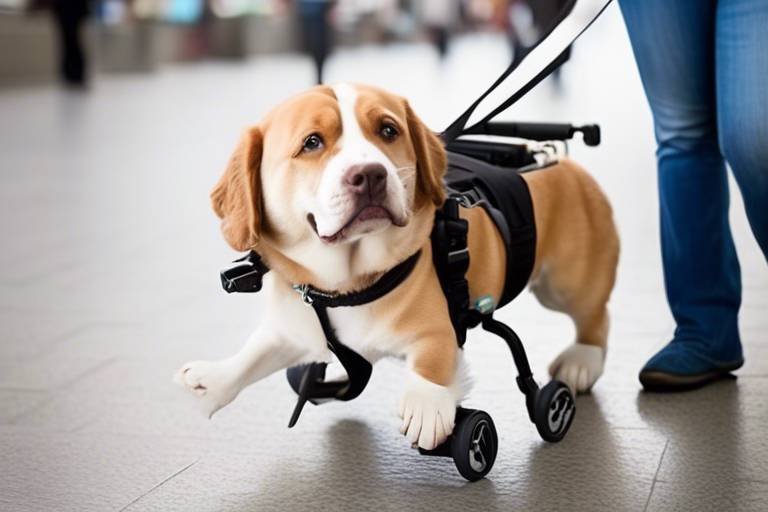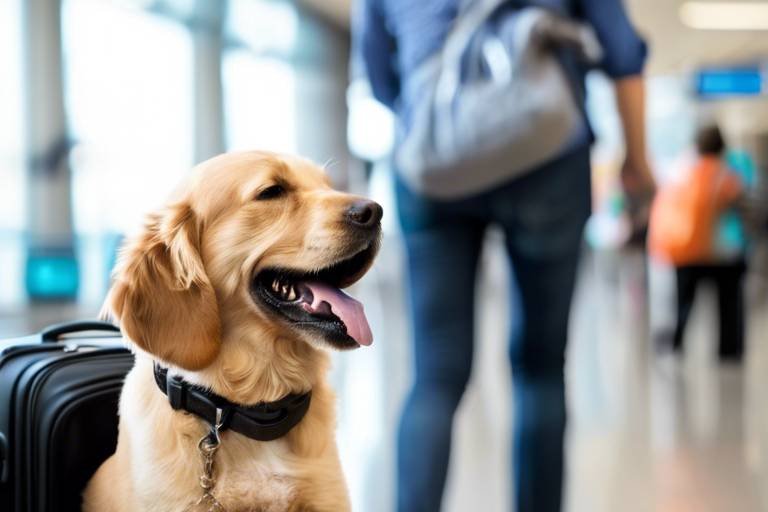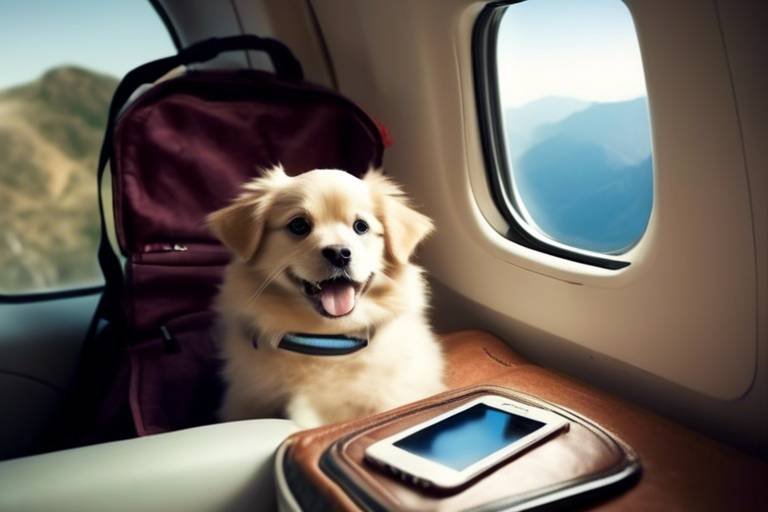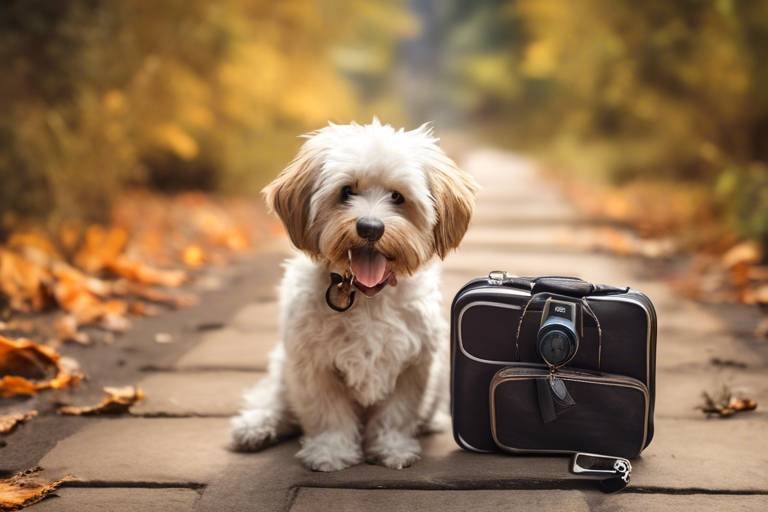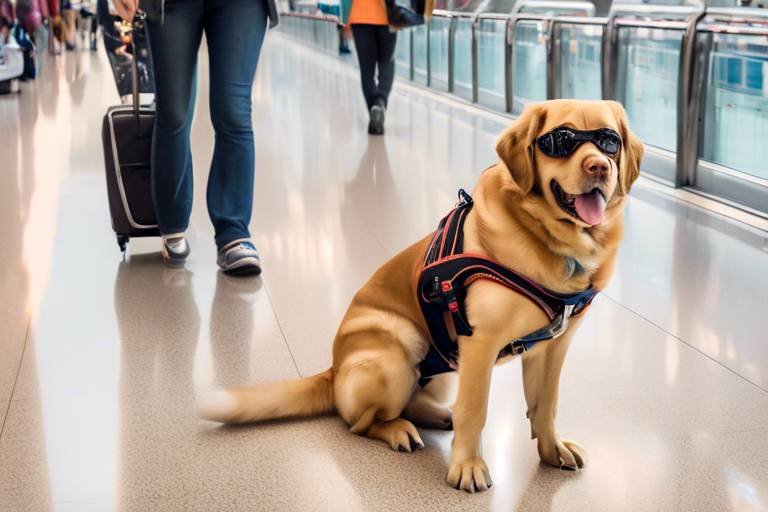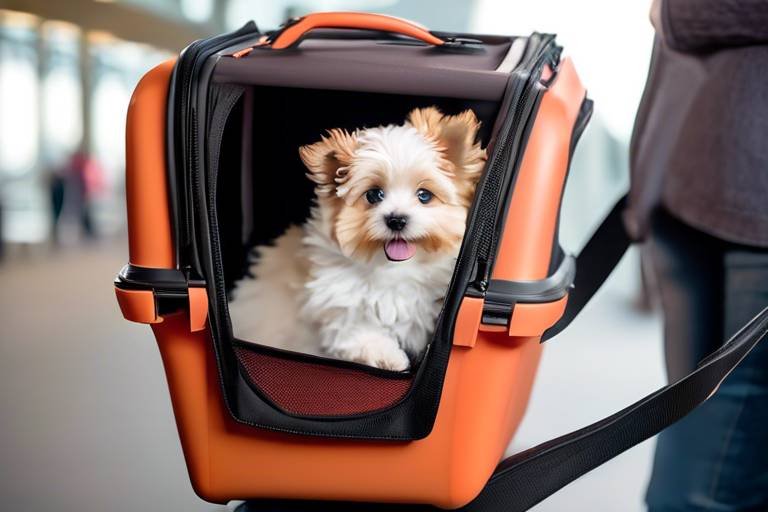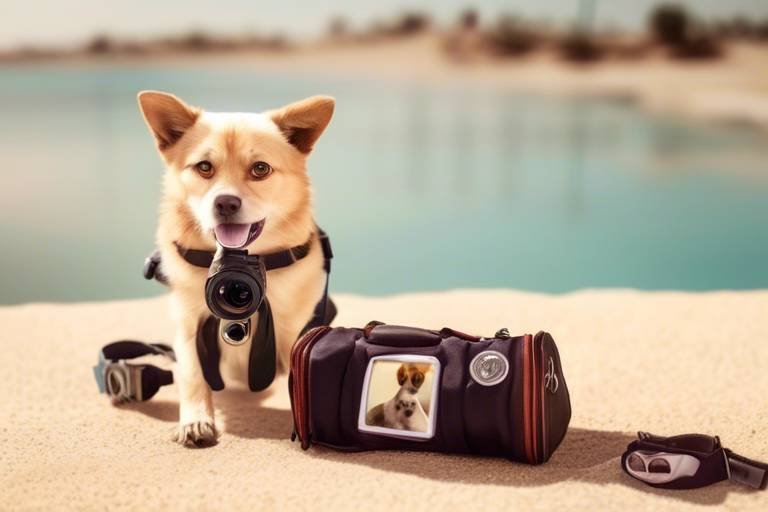The Importance of Routine During Travel for Pets
Traveling with pets can be both an exciting adventure and a daunting task. Just like humans, our furry friends thrive on routine. Maintaining a consistent schedule while on the road is crucial for their well-being. Imagine being in a new place, with unfamiliar smells and sounds, and then having your whole day turned upside down! That’s what pets experience when their routines are disrupted. By keeping a regular schedule for feeding, exercise, and downtime, we can help our pets feel more secure and less anxious during travel.
When pets are in a new environment, they can easily become overwhelmed. This is where the importance of routine shines through. A familiar schedule provides a sense of normalcy that can significantly ease their stress. Just think about it: if you were in a strange place, wouldn’t you appreciate having some familiar rituals to cling to? The same goes for our pets. By sticking to their usual routines, we can help them navigate the chaos of travel with a bit more confidence.
Moreover, a consistent routine during travel not only helps in reducing anxiety but also ensures the safety and health of our pets. For instance, regular feeding times prevent issues like digestive upset, while scheduled breaks for exercise and bathroom needs keep them comfortable and happy. It's all about creating a travel environment where they feel secure and cared for.
In a nutshell, the importance of routine during travel for pets cannot be overstated. It’s a simple yet effective way to enhance their travel experience, ensuring they stay healthy, happy, and stress-free. So, as you plan your next trip, remember that a little planning goes a long way in making the journey enjoyable for your furry companions.
- How can I tell if my pet is anxious while traveling?
Look for signs such as excessive barking, whining, pacing, or hiding. If your pet seems restless or overly clingy, they may be feeling stressed.
- What should I do if my pet refuses to eat while traveling?
Stick to their regular feeding schedule and offer their favorite foods. If they still refuse to eat, consult your vet for advice.
- Is it safe to travel with my pet in a crate?
Yes, using a crate can provide a safe and familiar environment for your pet during travel. Just make sure they are comfortable with the crate beforehand.
- How often should I stop for breaks during a long trip?
Plan to stop every 2-3 hours for bathroom breaks and exercise. This helps keep your pet comfortable and reduces anxiety.

Understanding Pet Anxiety
Travel can be a thrilling adventure for us humans, but for our furry friends, it can often feel like a rollercoaster ride of emotions. Just imagine being whisked away from your cozy home, tossed into a car or plane, and thrust into a completely new environment—it's no wonder our pets can feel anxious! Understanding pet anxiety is crucial for any pet owner, especially when planning a trip. Recognizing the signs of anxiety can help you take proactive steps to alleviate stress and create a more comfortable traveling experience for your beloved companion.
So, what exactly does pet anxiety look like? Pets may exhibit a range of behaviors when they're feeling anxious. These can include:
- Excessive barking or meowing: This vocalization can be a clear indication that your pet is feeling unsettled.
- Destructive behavior: Chewing on furniture or scratching at doors can signal that your pet is trying to cope with their anxiety.
- Hiding: If your pet suddenly seeks refuge under the bed or in a corner, it’s a sign they’re feeling overwhelmed.
- Loss of appetite: A stressed pet may refuse to eat, which can lead to additional health concerns.
- Excessive licking or grooming: This behavior can be a coping mechanism for anxious pets.
Understanding these signs is the first step in addressing your pet's anxiety. It's important to remember that just like humans, pets can experience varying degrees of anxiety. Some may only show mild signs, while others might exhibit severe reactions. Factors such as age, breed, and past experiences can all play a role in how your pet responds to travel. For instance, a rescue animal may have a heightened sense of fear due to previous trauma, making them more susceptible to anxiety during travel.
Now, let's talk about the environment. Many pets thrive on routine and familiarity, so being taken out of their comfort zone can be quite distressing. Whether it's the sounds of the car engine, the bustling airport, or the strange smells of a hotel room, these new experiences can overwhelm them. Creating a calming atmosphere can significantly help in reducing their anxiety levels. You might consider using calming aids such as pheromone sprays or anxiety wraps that can provide additional comfort during travel.
Ultimately, the key to easing pet anxiety during travel lies in preparation and understanding. By recognizing the signs and being aware of your pet's unique needs, you can take steps to make their travel experience as smooth as possible. Remember, just like us, our pets can feel a mix of excitement and apprehension when faced with new experiences, and it's our job to help guide them through it.

Benefits of a Consistent Schedule
When it comes to traveling with our furry friends, one of the most effective ways to keep their spirits high and anxiety low is by sticking to a consistent schedule. Just like us, pets thrive on routine; it gives them a sense of security and predictability. Imagine how you would feel if your daily routine was suddenly thrown into chaos—it's unsettling, right? Well, for our pets, travel can feel just like that. By establishing a reliable schedule for feeding, walking, and playtime, we can significantly ease their stress levels and help them adapt to the unpredictable nature of travel.
Think about it: when you're on the road, everything is unfamiliar. The sights, the sounds, the smells—they're all new and potentially overwhelming. By maintaining a routine, we can provide our pets with a comforting anchor amidst the whirlwind of new experiences. For instance, if your dog is used to eating at 7 AM and 6 PM, sticking to those feeding times can help them feel more at home, even in a hotel room or a friend's house. This consistency not only keeps their spirits up but also helps to prevent digestive issues that can arise from sudden changes in diet or meal timing.
Furthermore, a regular schedule can also aid in managing your pet's bathroom needs. When you set specific times for walks or bathroom breaks, it helps your pet know what to expect. This predictability can reduce accidents and the anxiety that comes with them. After all, nobody wants to deal with a stressed-out pet who doesn't know where or when they can relieve themselves!
In addition to feeding and bathroom breaks, incorporating playtime into your travel routine is equally important. Pets, especially dogs, need to expend energy to stay calm and relaxed. By scheduling regular play sessions, you not only help them burn off excess energy but also reinforce the bond you share. Engaging in a game of fetch or tug-of-war can be a fantastic way to distract them from the stress of travel and keep their spirits high.
To summarize, maintaining a consistent schedule while traveling with pets offers multiple benefits:
- Reduces Anxiety: A regular routine helps pets feel secure.
- Prevents Digestive Issues: Consistent feeding times keep their stomachs happy.
- Aids in Bathroom Management: Predictable bathroom breaks reduce accidents.
- Enhances Bonding: Scheduled playtime strengthens the pet-owner relationship.
By being mindful of these aspects and committing to a consistent schedule, you not only make the travel experience smoother for your pet but also create lasting memories that both you and your furry companion will cherish. So, the next time you hit the road, remember that a little routine goes a long way in keeping tails wagging and spirits high!
1. How can I maintain my pet's feeding schedule while traveling?
You can maintain your pet's feeding schedule by planning your travel itinerary around their meal times. Bring their regular food along and try to feed them at the same times as you would at home.
2. What should I do if my pet refuses to eat while traveling?
It's common for pets to lose their appetite during travel. If this happens, try offering their favorite treats or wet food to entice them. Ensure they have a comfortable and quiet space to eat.
3. How often should I exercise my pet during travel?
Aim for at least one good exercise session per day, but adjust based on your pet's energy levels and the travel schedule. Short walks and play sessions can help them release pent-up energy.
4. Can I use a crate for my pet during travel?
Absolutely! A crate can provide a safe and familiar space for your pet. Just make sure to introduce it to them before the trip so they associate it with positive experiences.
Feeding Times
This article explores the significance of maintaining a routine for pets while traveling, highlighting how it can ease their anxiety, ensure safety, and contribute to their overall well-being.
Travel can be stressful for pets. Recognizing the signs of anxiety in animals helps owners take proactive steps to alleviate stress and create a more comfortable traveling experience.
Establishing a consistent schedule for feeding, walking, and playtime can significantly reduce anxiety in pets. A routine provides a sense of security and familiarity, making travel less daunting.
Maintaining regular feeding times during travel is crucial for helping pets adjust to their new environment. Just like humans, pets thrive on routine, and a consistent feeding schedule can prevent them from feeling disoriented in unfamiliar settings. Imagine how you would feel if your meal times suddenly changed while you were away from home—pets experience similar discomfort when their feeding routine is disrupted. Regular feeding times not only help in managing their hunger but also play a significant role in preventing digestive issues that can arise from irregular eating patterns.
When planning your travel itinerary, it’s essential to incorporate feeding times into your schedule. For instance, if you typically feed your dog at 8 AM and 6 PM, try to stick to these times as closely as possible, even if you’re in a different location. This consistency helps signal to your pet that, despite the change in scenery, some things remain the same. To help you keep track, consider using a simple table:
| Time | Activity |
|---|---|
| 8:00 AM | Breakfast |
| 12:00 PM | Midday Walk |
| 6:00 PM | Dinner |
| 8:00 PM | Evening Playtime |
Additionally, keeping their diet consistent is crucial for their health and comfort. If you usually feed your pet a specific brand of kibble, pack enough to last the entire trip. Switching foods suddenly can lead to gastrointestinal upset, which is the last thing you want to deal with while traveling. If you must change their diet, do so gradually over a few days before your trip to avoid any tummy troubles.
Another important aspect to remember is hydration. Pets can get dehydrated quickly, especially when traveling. Make sure to have fresh water available at all times and offer it to them regularly, especially during long drives or flights. Frequent water breaks not only keep them hydrated but also give them a chance to stretch their legs and relieve themselves, which is vital for their comfort.
A designated safe space for pets during travel can help them feel secure. Familiar items, like blankets or toys, can provide comfort and stability in unfamiliar settings.
Using a crate during travel offers pets a secure environment. It’s important to introduce the crate beforehand to ensure they associate it with safety and comfort.
Gradually introducing pets to new environments can ease their anxiety. Allowing them to explore at their own pace fosters confidence and comfort in unfamiliar surroundings.
- How can I tell if my pet is anxious while traveling? Look for signs such as excessive barking, whining, pacing, or hiding. If your pet seems restless or overly clingy, they may be feeling anxious.
- What should I do if my pet refuses to eat during travel? Try offering their favorite treats or food. If they continue to refuse, don’t force them but ensure they stay hydrated.
- Is it safe to travel with pets in a crate? Yes, crates can provide a secure environment for pets. Just make sure they are comfortable with the crate before the trip.
Choosing the Right Food
When it comes to traveling with your beloved pet, one of the most crucial aspects to consider is food. Just like us, pets thrive on consistency, and maintaining their usual diet can make a world of difference in their travel experience. Imagine being whisked away to a new place without your favorite snacks—pretty unsettling, right? For pets, the same principle applies, and selecting the right food can ease their transition and keep their tummies happy.
First and foremost, it's essential to stick to their usual brand and type of food. This familiarity helps reduce the chances of gastrointestinal upset, which can be a common issue when pets are subjected to sudden dietary changes. It’s like asking a child to eat a completely different cuisine when they’re used to their mom’s homemade mac and cheese—chaos is bound to ensue! So, when packing for your trip, make sure you bring along their regular food. If you anticipate running out, consider packing a bit extra, just in case.
Another tip is to pay attention to the packaging. Ensure the food is stored in a secure, airtight container to keep it fresh during the journey. You can even use resealable bags for easy access and portion control. When it comes to feeding time, try to stick to the same schedule you follow at home. If they usually eat breakfast at 8 AM, aim for that time, even if you're in a hotel room. This consistency acts as an anchor in the whirlwind of travel, providing a sense of normalcy amidst the chaos.
In addition to their regular food, don’t forget about hydration! Pets need to stay hydrated, especially during travel. Make sure to have a portable water bowl handy and offer them water regularly. This routine not only keeps them refreshed but also reinforces the idea that their needs are being met, even in new surroundings.
In summary, choosing the right food for your pet during travel involves a few key steps:
- Stick to familiar brands: Avoid sudden dietary changes to prevent digestive issues.
- Pack extra food: Always have more than you think you’ll need.
- Maintain a consistent feeding schedule: Keep feeding times as close to normal as possible.
- Ensure hydration: Regularly offer water to keep your pet hydrated.
By following these guidelines, you can help ensure that your pet remains comfortable and happy throughout your travels. Remember, a well-fed pet is a happy pet, and that’s the ultimate goal when on the road!
Q: Can I change my pet's food while traveling?
A: It's best to avoid changing your pet's food during travel to prevent digestive issues. Stick to their usual diet as much as possible.
Q: How can I ensure my pet stays hydrated?
A: Bring a portable water bowl and offer water regularly during travel. Make hydration a part of your routine.
Q: What if my pet refuses to eat while traveling?
A: If your pet is hesitant to eat, try offering their food at their usual feeding times. You can also tempt them with a little bit of wet food or a favorite treat.
Hydration Needs
When it comes to traveling with your furry friends, ensuring that they remain hydrated is absolutely crucial. Just like us, pets can become dehydrated, especially when they are exposed to new environments, changes in temperature, and different routines. Imagine how you feel after a long day of travel—thirsty and a bit out of sorts. Your pet experiences similar discomfort, and it’s our job as responsible pet owners to keep them feeling their best.
To maintain proper hydration levels, it’s essential to incorporate regular water breaks into your travel itinerary. This means stopping at intervals to offer your pet fresh water, which not only quenches their thirst but also helps them adjust to the rhythm of travel. If you’re on a long road trip, aim to stop every couple of hours to let your pet stretch their legs and drink some water. This routine not only keeps them hydrated but also gives them a chance to relieve themselves and explore a little.
Additionally, it’s wise to carry a portable water bowl or a spill-proof container. This way, you can easily provide water during rest stops or even in the car. If your pet is particularly picky or sensitive about their drinking water, consider bringing along a supply of water from home to ensure they’re comfortable. After all, nothing can ruin a fun trip faster than an upset stomach from drinking unfamiliar water!
Another important aspect of hydration is to be mindful of your pet's activity level. If you're planning on hiking or engaging in other physically demanding activities, your pet will need even more water. Monitor their behavior; if they seem lethargic or are panting excessively, it may be a sign that they need to hydrate. Remember, pets can’t tell us when they’re thirsty, so it’s up to us to keep an eye on their needs.
In conclusion, keeping your pet hydrated during travel is not just a good idea; it's a necessity. By establishing a routine that includes regular water breaks and being mindful of their hydration needs, you can help ensure that your pet remains healthy and happy throughout your journey. So, pack that water bowl, keep an eye on their drink intake, and watch as your pet thrives on the road!
- How often should I offer my pet water while traveling?
It's best to offer water every couple of hours, especially during long trips or on hot days. - What if my pet refuses to drink water while traveling?
Try offering water in a familiar bowl, or use enticing methods like adding a splash of low-sodium broth to encourage drinking. - Can I give my pet ice cubes for hydration?
Yes, ice cubes can be a fun and refreshing way to keep your pet hydrated, especially in hot weather. - What signs should I look for to know if my pet is dehydrated?
Watch for signs like dry gums, excessive panting, lethargy, and loss of skin elasticity.
Exercise and Play
This article explores the significance of maintaining a routine for pets while traveling, highlighting how it can ease their anxiety, ensure safety, and contribute to their overall well-being.
Travel can be stressful for pets. Recognizing the signs of anxiety in animals helps owners take proactive steps to alleviate stress and create a more comfortable traveling experience.
Establishing a consistent schedule for feeding, walking, and playtime can significantly reduce anxiety in pets. A routine provides a sense of security and familiarity, making travel less daunting.
Maintaining regular feeding times during travel helps pets adjust to their new environment and prevents digestive issues. Consistency in diet is crucial for their health and comfort.
Selecting familiar food options can ease the transition for pets. It’s essential to keep their diet consistent to avoid gastrointestinal upset while on the road.
Ensuring pets stay hydrated is vital during travel. Regularly scheduled water breaks can prevent dehydration and keep pets feeling their best throughout the journey.
Incorporating exercise and playtime into travel routines helps pets expend energy and reduces stress. Just like humans, pets can feel cooped up and anxious when they don’t have an outlet for their energy. Imagine being stuck in a car for hours without a chance to stretch your legs or play a game—it's not a pleasant thought, right? For pets, regular physical activity is essential for their mental and physical health. Not only does it help burn off excess energy, but it also provides an opportunity for bonding between you and your furry friend.
When planning travel, consider scheduling short breaks where you can take your pet for a walk or engage in a quick game of fetch. These moments not only offer relief from confinement but also allow your pet to explore new environments, which can be exciting and stimulating. Here are some activities you might consider during your stops:
- Short Walks: A brisk walk can do wonders for your pet's mood.
- Play Fetch: If you have a safe space, a quick game of fetch can be exhilarating.
- Interactive Toys: Bring along a favorite toy to keep them engaged.
Additionally, if you're traveling to a pet-friendly destination, plan for longer sessions of exercise, such as hiking or visiting a dog park. These outings can significantly enhance your pet's travel experience, making it more enjoyable and less stressful. Remember, a tired pet is often a happy pet, and a happy pet means a more relaxed travel experience for you!
A designated safe space for pets during travel can help them feel secure. Familiar items, like blankets or toys, can provide comfort and stability in unfamiliar settings.
Using a crate during travel offers pets a secure environment. It’s important to introduce the crate beforehand to ensure they associate it with safety and comfort.
Gradually introducing pets to new environments can ease their anxiety. Allowing them to explore at their own pace fosters confidence and comfort in unfamiliar surroundings.
Q: How can I tell if my pet is anxious during travel?
A: Signs of anxiety in pets can include excessive barking, whining, panting, or trying to escape. If your pet seems restless or hides, they may be feeling stressed.
Q: What should I do if my pet refuses to eat while traveling?
A: It's common for pets to lose their appetite when in a new environment. Try offering small, familiar treats to entice them, and ensure they have access to fresh water.
Q: Can I give my pet medication for anxiety during travel?
A: Consult with your veterinarian before giving your pet any medication. They can recommend safe options tailored to your pet’s needs.
Q: How often should I exercise my pet during travel?
A: Aim for short exercise breaks every few hours to help your pet stretch, relieve themselves, and reduce anxiety.

Creating a Safe Space
When embarking on a journey with your beloved pet, one of the most crucial aspects to consider is creating a safe space for them during travel. Just like humans, pets thrive in environments where they feel secure and comfortable. Imagine being in a new place, surrounded by unfamiliar sounds and sights; it can be overwhelming! By establishing a safe zone for your furry friend, you can significantly reduce their anxiety and help them adjust to the new surroundings.
To create this sanctuary, start by incorporating familiar items that your pet loves. This could be their favorite blanket, a plush toy, or even an article of your clothing that carries your scent. These items serve as a comforting reminder of home, making the transition to new environments much smoother. The presence of these familiar objects can be likened to a child holding onto a teddy bear during a scary movie; it provides reassurance and a sense of safety.
Additionally, consider the layout of the travel space. If you’re traveling by car, designating a specific area in the vehicle where your pet can relax is essential. This could be a cozy pet seat cover or a designated crate that they can call their own. A crate not only offers a confined space where they can feel secure but also protects them during sudden stops or turns. Just remember, it’s vital to introduce the crate to your pet before the trip, allowing them to explore and get accustomed to it at their own pace. This way, they’ll associate the crate with safety and comfort rather than confinement.
Moreover, if your travels involve staying in hotels or unfamiliar homes, setting up a temporary space for your pet can work wonders. Once you arrive, take a few moments to arrange their area with their bed, toys, and food and water bowls. This small act can transform a strange place into a cozy retreat for your pet. Think of it as setting up a campsite; you wouldn’t just throw down a sleeping bag without preparing the area first! Creating a familiar environment helps your pet feel more at ease, allowing them to explore their surroundings with confidence.
Lastly, it’s essential to monitor your pet's behavior during travel. Just as we might feel anxious in new situations, pets can experience similar emotions. Look for signs of stress, such as excessive panting, whining, or hiding. If you notice these signs, take a moment to reassure your pet, perhaps by speaking softly to them or giving them a gentle pat. Remember, your calm demeanor can greatly influence how your pet perceives the situation. By maintaining a relaxed atmosphere, you can help your pet feel more secure and less anxious.
- What should I include in my pet's travel kit?
It's essential to pack their regular food, water, bowls, a leash, waste bags, grooming supplies, and their favorite toys or blankets. This ensures they have everything they need for comfort and familiarity.
- How can I help my pet adjust to new environments?
Allow your pet to explore their new surroundings at their own pace. Gradually introduce them to new spaces while ensuring they have access to their safe zone.
- Is it necessary to use a crate during travel?
While not mandatory, using a crate can provide a safe and secure space for your pet, especially during car trips. Just make sure they are accustomed to it before the journey.
Traveling with Crates
When it comes to traveling with pets, using a crate can be a game changer. Imagine a cozy little den that your furry friend can retreat to amidst the chaos of travel. A crate isn't just a means of transport; it can be a sanctuary for your pet, providing them with a sense of safety and security. However, to ensure that your pet views the crate as a positive space, it's crucial to introduce it well before your journey. This can be achieved by allowing your pet to explore the crate at their own pace, perhaps by placing their favorite blanket or toy inside to make it feel like home.
It's essential to choose the right size of crate. A crate should be spacious enough for your pet to stand, turn around, and lie down comfortably, but not so large that they can use one end as a bathroom. This balance will help them feel secure while also preventing accidents during travel. For example, if you have a medium-sized dog, a crate that measures approximately 30 inches long might be ideal. You can refer to the following table for guidance on crate sizes based on pet breeds:
| Pet Size | Suggested Crate Size | Example Breeds |
|---|---|---|
| Small | 24-30 inches | Chihuahua, Pomeranian |
| Medium | 30-36 inches | Cocker Spaniel, Beagle |
| Large | 36-42 inches | Labrador Retriever, Boxer |
| Extra Large | 42-48 inches | Great Dane, Mastiff |
Once your pet is accustomed to their crate, it’s time to make it a part of your travel routine. During the journey, you can place the crate in a secure spot in your vehicle, ensuring it's well-ventilated and away from direct sunlight. Regular breaks are essential; let your pet out of the crate to stretch their legs and relieve themselves. This not only keeps them comfortable but also helps reduce anxiety. If your pet shows signs of distress while in the crate, speaking to them in a calm, soothing voice can help reassure them that everything is okay.
In conclusion, traveling with a crate can significantly enhance your pet's travel experience. It provides them with a familiar space that they can rely on, making the journey less stressful. Remember, the key is to make the crate a positive place long before you hit the road. With a little preparation and patience, you can ensure that your pet feels safe and secure, allowing you both to enjoy the adventure ahead!
- How do I get my pet used to the crate? Start by introducing the crate in a positive way. Allow your pet to explore it at their own pace, using treats and toys to create a positive association.
- What if my pet refuses to enter the crate? Try placing their favorite blanket or toy inside the crate. You can also try feeding them their meals near or inside the crate to encourage them.
- Is it safe to leave my pet in the crate during long trips? Yes, but ensure that you take regular breaks for them to stretch, hydrate, and relieve themselves.
Acclimating to New Environments
Traveling to new places can be an exciting adventure for both you and your furry friend, but it can also be a source of stress and anxiety. Just like us, pets can feel overwhelmed when they find themselves in unfamiliar surroundings. To make the transition smoother for your pet, it’s crucial to help them acclimate to new environments gradually. Think of it as a gentle introduction to a new world, rather than a sudden plunge into the deep end.
One effective way to ease your pet into a new space is to allow them to explore at their own pace. Instead of forcing them to confront every corner of a new hotel room or campsite all at once, give them the freedom to sniff around and investigate their surroundings. This exploration can be akin to how a child might feel when they first step into a new playground; some might dive in headfirst, while others prefer to linger on the outskirts, observing before joining in. By giving your pet the time they need, you can help foster a sense of security and confidence.
To further enhance their comfort, consider bringing along some familiar items from home. A favorite blanket or toy can work wonders in providing a sense of familiarity amidst the chaos of travel. Just imagine how comforting it would be to have a piece of home with you in an unfamiliar place! This small gesture can significantly reduce anxiety and help your pet feel more at ease.
Additionally, creating a routine even in new environments can be incredibly beneficial. For example, if you normally feed your pet at a specific time, try to stick to that schedule as closely as possible. This consistency can provide a reassuring anchor in the midst of change. Similarly, maintaining regular walking times can help your pet adjust to their new surroundings while also allowing them to relieve any pent-up energy.
Lastly, be patient and observant. Every pet is unique, and their response to new environments can vary widely. Some may adapt quickly, while others might take a bit more time. Keep an eye out for signs of stress, such as excessive barking, hiding, or refusal to eat. If you notice these behaviors, take a step back and give them the space they need. Remember, the goal is to make travel a positive experience for both you and your pet.
- How long does it typically take for pets to acclimate to new environments?
It varies by pet; some may adjust within a few hours, while others might take days or even weeks. Patience is key! - What items should I bring to help my pet feel more at home?
Familiar toys, blankets, and even their regular food and water bowls can help provide comfort. - Are there specific signs of anxiety I should watch for?
Yes, look for behaviors like excessive barking, hiding, or a refusal to eat, which can indicate stress.
Frequently Asked Questions
- Why is maintaining a routine important for pets during travel?
Maintaining a routine helps alleviate anxiety in pets by providing them with a sense of security and familiarity in unfamiliar environments. Just like us, pets thrive on predictability, and a consistent schedule for feeding, walking, and playtime can make all the difference in their comfort levels.
- What signs of anxiety should I watch for in my pet while traveling?
Common signs of anxiety in pets include excessive barking, panting, hiding, or changes in appetite. If your furry friend seems restless or is trying to escape their crate, it's a clear indication that they may be feeling stressed. Recognizing these signs early can help you take proactive steps to ease their anxiety.
- How can I ensure my pet stays hydrated during travel?
To keep your pet hydrated, schedule regular water breaks throughout the journey. Offering water every couple of hours or during rest stops can prevent dehydration. Always carry a portable water bowl, so your pet can drink comfortably, just like you would want a refreshing drink on a long road trip!
- What should I do if my pet refuses to eat while traveling?
If your pet is hesitant to eat, try offering their usual food in smaller portions or at their regular feeding times. If they continue to refuse, don’t force them; instead, consult with your veterinarian to rule out any underlying health issues or get advice on suitable alternatives while on the go.
- How can I create a safe space for my pet during travel?
Creating a safe space involves using familiar items like their favorite blanket or toys in their travel crate or designated area in the vehicle. This familiarity can provide comfort and help them feel secure, allowing them to relax during the journey.
- Is it necessary to use a crate when traveling with my pet?
Using a crate can be very beneficial as it provides a secure environment for your pet. It's essential to introduce the crate to your pet before the trip so they can associate it with safety and comfort. Think of it as their own little sanctuary on wheels!
- How can I help my pet acclimate to new environments while traveling?
Gradual exposure is key! Allow your pet to explore new places at their own pace. Start by letting them sniff around and get comfortable with the surroundings. This method helps build their confidence and reduces anxiety in unfamiliar settings.

